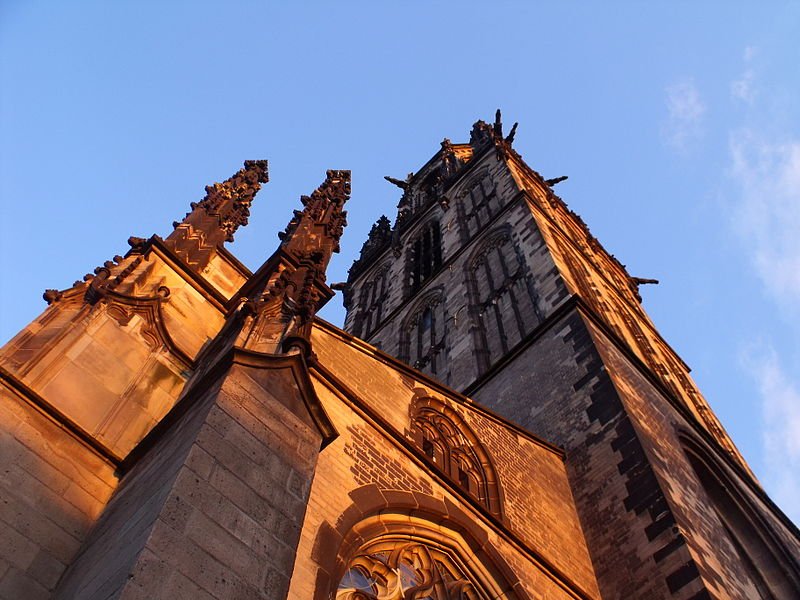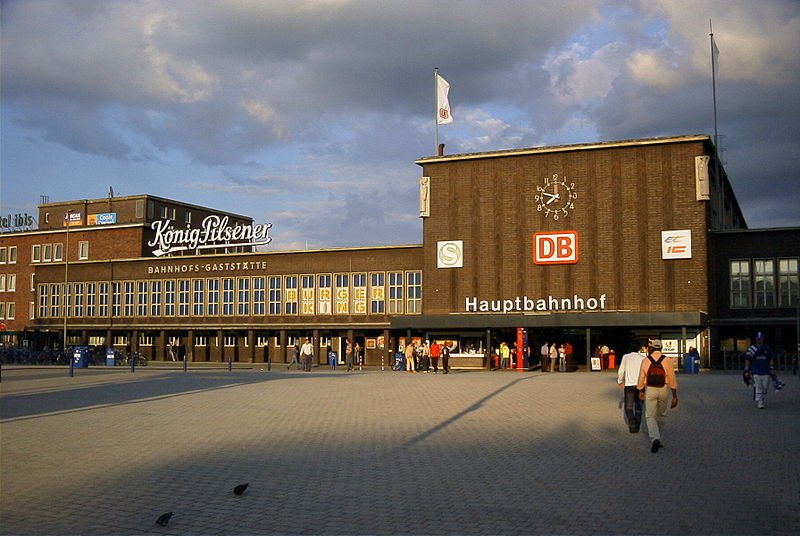 Friedrich Ebert Bridge, Duisburg, Germany
Friedrich Ebert Bridge, Duisburg, GermanySource: https://commons.wikimedia.org/wiki/File:Duisburg,_2011-01_CN-V,_Friedrich-Ebert-Br%C3%BCcke.jpg
Author: kaʁstn

Duisburg is a city on the western part of the Ruhr Area, in the state of North Rhine-Westphalia. Located within the Düsseldorf administrative district, Duisburg covers 232.82 sq km (89.89 sq mi) and has a population of 500,000 (2011 estimate). It ranks 15th among the most populous cities in Germany and 5th among the cities in North Rhine-Westphalia. The city observes the Central European Time (UTC+1) and in summer the Central European Summer Time (UTC+2).
 Main street in Mündelheim, a neighborhood of Duisburg, with St Dionysius Church on the right
Main street in Mündelheim, a neighborhood of Duisburg, with St Dionysius Church on the rightSource: https://commons.wikimedia.org/wiki/File:Ortsmitte_Duisburg-M%C3%BCndelheim.JPG
Author: ZebraDS

Duisburg is located at the confluence of the Rhine and Ruhr River, a strategic location that propels its harbour to become the biggest inland harbour in the world. Together, along with the proximity of the Düsseldorf International Airport, makes the city a choice location for business and manufacturing.
Duisburg is a major center of heavy industry in Germany, producing the lion's share of hot metal and pig-iron in Germany. Unlike under cities in the Ruhr area, Duisburg was never a major coal-mining center. Its last coal mine closed in 2009. Apart from its heavy industries, Duisburg is also the producer of König Pilsener, a major brand of beer in the country.
 Salvatorkirche, Duisburg
Salvatorkirche, DuisburgSource: https://commons.wikimedia.org/wiki/File:Salvatorkirche_Turm_(Duisburg)_4.JPG
Author: Oceancetaceen

According to legend - as recorded by 16th century Bavarian historian Johannes Aventinus, Duisburg was established by Tuisto, the divine ancestor of the Germans, whose name is given to the city. Archaeological research shows that a settlement has been founded there by the first century AD. It grew into a trading town by the 5th century.
The industrial development of Duisburg dates to the 18th century. At that time, it was part of the Prussian Rhine Province. Major iron and steel companies such as Thyssen and Krupp established their operations in the city. Railway lines were constructed to connect it with other major cities in the Ruhr area, including Düsseldorf and Dortmund.
Due to its various heavy industries, Duisburg was a major target of Allied bombers during the Second World War. A raid by 577 bombers on 12-13 May, 1943, dropped 1,599 tons of bombs on Duisburg, destroying its Old Town and killing countless civilians. Another 2,000 tons of bombs fell on the city on 22 May, 1944, followed by 2,018 tons on 14 October, 1944. A daytime operation was followed the same night when 9,000 tons of bombs was dropped on the city.
 Factories in the Duisburg Industrial Landscape Park, Duisburg
Factories in the Duisburg Industrial Landscape Park, DuisburgSource: https://commons.wikimedia.org/wiki/File:Duisburg_%28DerHexer%29_2010-08-11_019.jpg
Author: DerHexer

By the end of the war, Duisburg had endured 299 bombing raids that completely destroyed the city, requiring the whole city to be rebuilt. The result is that most of its historic landmarks are now gone. Nevertheless major buildings such as the Salvatorkirche was rebuilt.
Today Duisburg is a modern German city that has fully recovered from its past war devastations. During its decades of redevelopment, it attracted immigrant workers, mainly Turks, who took on the low-paying jobs as Gastarbeiter ("guest workers"). Today the city has some 60,000 Turkish Muslims. The new Merkez Mosque, the main place of worship for the Muslims in Duisburg, is the largest mosque in a non-Muslim country. Its construction was funded by the EU and the state of North Rhine-Westphalia.
 Duisburg Railway Station
Duisburg Railway StationSource: https://commons.wikimedia.org/wiki/File:Hauptbahnhof_Duisburg,_Vorplatz_Eingang_West,_2004.jpg
Author: BlackIceNRW

Visiting Duisburg, Germany
The nearest airport to Duisburg is the Düsseldorf International Airport (DUS). From the airport, take a train to the Düsseldorf Railway Station and transfer to a train to Duisburg.Places of Interest in Duisburg
- Kulture- und Stadthistorisches Museum
Museum exhibiting local artifacts and works of local geographer and cartographer Gerhard Mercator. - Merkez-Moschee
Biggest mosque in a non-Muslim country. - Museum der Deutschen Binnenschifffahrt
The Museum of German Inland Navigation showcases a collection of barges and other vessels on the German inland waterways. - Salvatorkirche
Gothic-style church that was rebuilt after being destroyed in the Second World War. - Wilhelm-Lehmbruck-Museum
Museum showcasing the works of the famous sculptor who was born in Duisburg.
 Interior of Merkez-Moschee, Duisburg, the biggest mosque in a non-Muslim country
Interior of Merkez-Moschee, Duisburg, the biggest mosque in a non-Muslim countrySource: https://commons.wikimedia.org/wiki/File:Duisburg_Merkez-Moschee_Innen_4.jpg
Author: Zairon

 Latest updates on Penang Travel Tips
Latest updates on Penang Travel Tips
About this website

Thanks for reading this page. My name is Timothy Tye. My hobby is to research information about places, and share the information with people on this website. I started this website on 5 January 2003, and since then, have written about over 20,000 places, mostly in Malaysia and Singapore.
Please use the information on this page as guidance only. While I try my best to provide you information that is as accurate as I can get it to be, I do apologize for any errors. Also, as I might not be able to update some information on time, some of these pages may contain outdated information.
Copyright © 2003-2024 Timothy Tye. All Rights Reserved.


 Go Back
Go Back